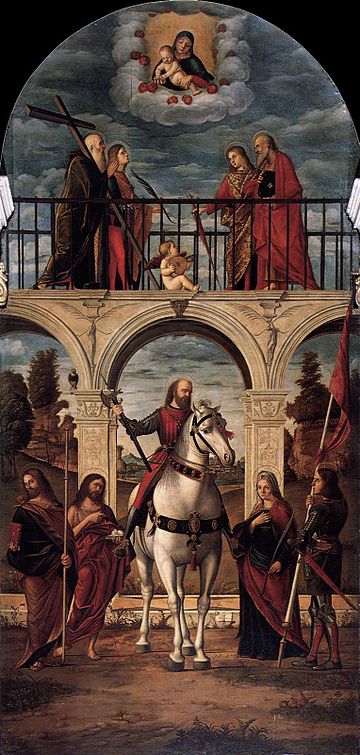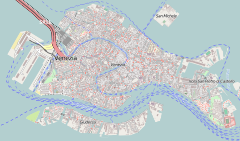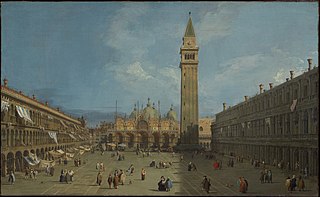
Piazza San Marco, often known in English as St Mark's Square, is the principal public square of Venice, Italy, where it is generally known just as la Piazza. All other urban spaces in the city are called campi ("fields"). The Piazzetta is an extension of the Piazza towards San Marco basin in its south east corner. The two spaces together form the social, religious and political centre of Venice and are commonly considered together. This article relates to both of them.

The Doge's Palace is a palace built in Venetian Gothic style, and one of the main landmarks of the city of Venice in northern Italy. The palace was the residence of the Doge of Venice, the supreme authority of the former Venetian Republic. It was founded in 1340, and extended and modified in the following centuries. It became a museum in 1923, and is one of the 11 museums run by the Fondazione Musei Civici di Venezia.

The Chiesa di Santa Maria del Giglio is a church in Venice, Italy.
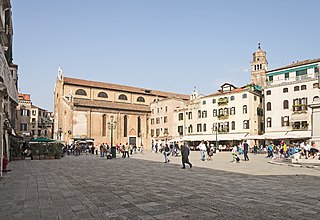
The Chiesa di Santo Stefano is a large Roman Catholic church at the northern end of the Campo Santo Stefano in the sestiere of San Marco, Venice, Italy.

The Basilica di San Giovanni e Paolo, known in Venetian as San Zanipolo, is a church in the Castello sestiere of Venice, Italy.

The Gallerie dell'Accademia is a museum gallery of pre-19th-century art in Venice, northern Italy. It is housed in the Scuola della Carità on the south bank of the Grand Canal, within the sestiere of Dorsoduro. It was originally the gallery of the Accademia di Belle Arti di Venezia, the art academy of Venice, from which it became independent in 1879, and for which the Ponte dell'Accademia and the Accademia boat landing station for the vaporetto water bus are named. The two institutions remained in the same building until 2004, when the art school moved to the Ospedale degli Incurabili.

Giambattista Pittoni or Giovanni Battista Pittoni was a Venetian painter of the late Baroque or Rococo period. He was among the founders of the Academy of Fine Arts of Venice, of which in 1758 he became the second president, succeeding Tiepolo.

Lombardo, the name of a family of Venetian sculptors and architects; their surname was apparently Solaro, and the name of Lombardo was given to the earliest known, Martino, who emigrated from Lombardy to Venice in the middle of the 15th century AD and became celebrated as an architect.

San Stae is a church in central Venice, in the sestiere of Santa Croce.
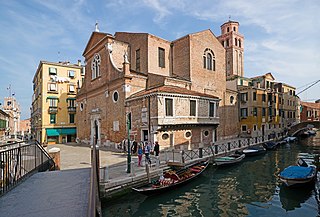
San Martino is a Renaissance Roman Catholic church in the sestiere of Castello of Venice, northern Italy.
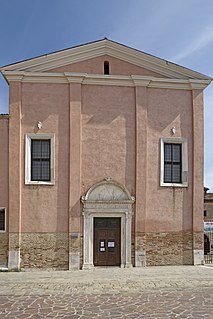
The Church of St Job is a 15th-century Roman Catholic church located overlooking the campo of the same name, known as Sant'Agiopo in Venetian dialect, on the south bank of the Cannaregio canal near Ponte dei Tre Archi in the sestiere of Cannaregio of Venice, northern Italy,
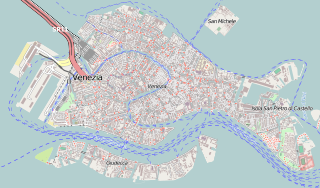
The Chiesa dei Santi Apostoli di Cristo, commonly called San Apostoli, is a 7th-century Roman Catholic church located in the Cannaregio sestiere of the Italian city of Venice. It is one of the oldest churches in the city and has undergone numerous changes since its foundation. The present building is the result of a major reconstruction project which was undertaken in 1575. The church is notable particularly for the Cornaro Chapel, an important example of Early Renaissance architecture, added by Mauro Codussi during the 1490s. The chapel is the burial place of several members of the powerful Cornaro family, including Catherine Cornaro, Queen of Cyprus and Armenia. The church houses several works of art including pieces by Giambattista Tiepolo and Paolo Veronese.

The church of Santa Maria Assunta, known as I Gesuiti, is a religious building in Venice, northern Italy. It is located in the sestiere of Cannaregio, in Campo dei Gesuiti, not far from the Fondamenta Nuove.

Santa Maria della Fava, also originally known as Santa Maria della Consolazione, is an ancient Roman Catholic church in the sestiere of Castello in Venice, Italy.

San Tomà is a church which is located in the sestiere of San Polo in Venice, Italy. It stands opposite the Scoletta dei Calegheri.
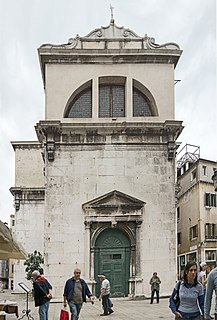
San Fantin is a church in the sestiere of San Marco in Venice, Italy. It stands in front of the Fenice Theater and adjacent to the Ateneo Veneto.

San Lio is a church located on the campo of the same name in the sestiere of Castello.

The Chiesa di San Barnaba is a small Neoclassical-style church in the sestiere (district) of Dorsoduro in Venice. It is dedicated to the Apostle Saint Barnabas.

San Francesco di Paola is a Roman Catholic church in Via Garibaldi in the Sestiere of Castello in Venice, Italy.

